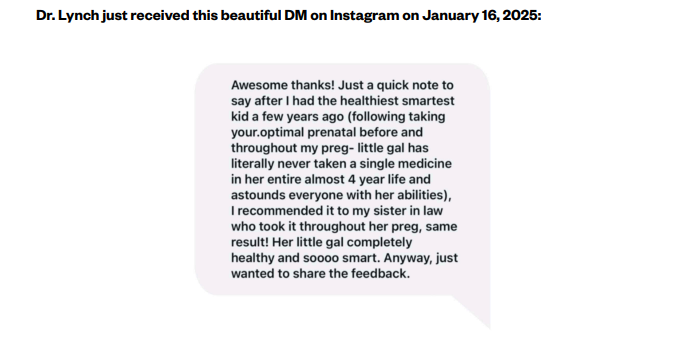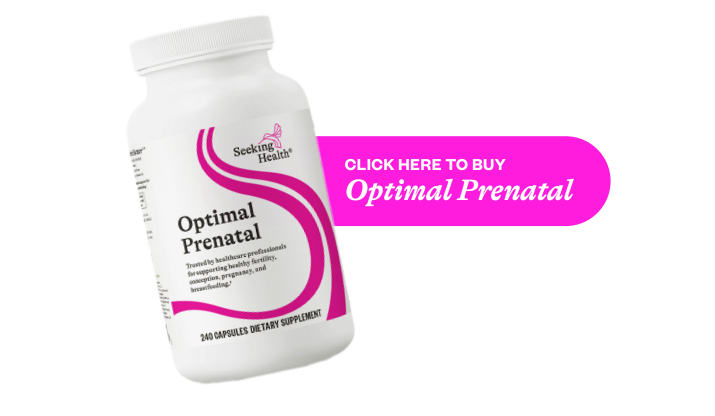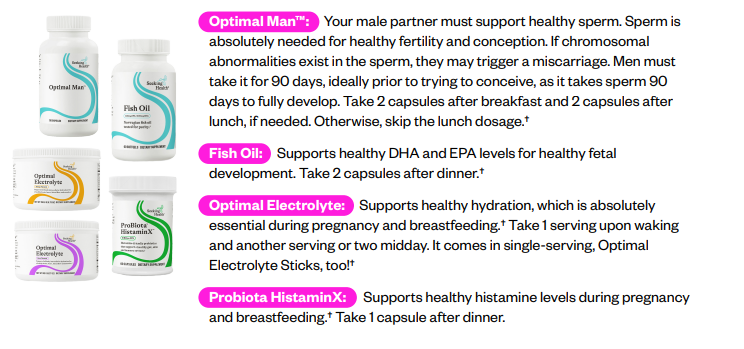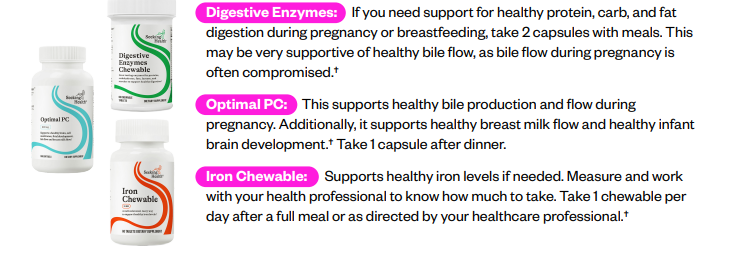How to use Optimal PrenatalUpdated 2 months ago

Prenatal vitamins are supportive for you, your developing baby, your placenta, and your grandchildren. The nutritional demands during pregnancy are very significant. By supporting your pregnancy with Optimal Prenatal, you’re getting comprehensive support that is not available elsewhere.† Optimal Prenatal was the first prenatal to provide the powerful combination of folinic acid, methylfolate, methylcobalamin, adenosylcobalamin, and choline. Dr. Lynch dedicated three years of research to formulating this prenatal. He formulates based on what current research states is the most supportive and effective. Over 40,000 women have trusted Optimal Prenatal with their pregnancies, representing 102 countries! 77% of these women used Optimal Prenatal throughout their entire pregnancy

Optimal Prenatal contains researched ingredients that support fertility1 , conception2 , pregnancy3 , breastfeeding4 , and overall postpartum female health.†
Why does Optimal Prenatal support these areas of health?†
Optimal Prenatal supports these areas of health through the synergy of all the B vitamins and chelated trace minerals in potent amounts. The addition of choline, real folate, antioxidants, high amounts of calcium and magnesium, ginger, and B6 support the relief of symptoms of occasional nausea and morning sickness. Dr. Lynch carefully selected specific nutrients for Optimal Prenatal while deliberately excluding others. For example, the formula does not include folic acid, a synthetic and vastly inferior form of folate that does not occur in nature—there are known dangers of folic acid. Instead, Optimal Prenatal features two naturally active forms of folate: methylfolate and folinic acid.5 Methylfolate supports healthy methylation, which is essential for healthy placental development, fetal development, and maternal blood flow.6 Folinic acid, on the other hand, supports DNA synthesis, the formation of red and white blood cells, neurotransmitter production, and healthy platelets.7,†
Here are some other reasons why Dr. Lynch used various nutrients—and did not use others:†
• Contains choline to support healthy fetal neurodevelopment, memory formation, and attention.8 • Utilizes two active forms of vitamin B12, as methylcobalamin and adenosylcobalamin, to support healthy methylation and energy.
• Has antioxidants to support healthy eggs, insulin levels, and a developing baby.9,10
• Calcium and magnesium are included to support healthy fetal development and mom’s health.11
• Natural ingredients like ginger, vitamin B6, and milk thistle help mothers feel more comfortable during occasional nausea or morning sickness.12
• Researched amounts of vitamin D (4,000 IU) for pregnancy and breastfeeding, along with healthy amounts of stable MK7 form of vitamin K2, are included in the formula.13
• Inositol to support healthy blood sugar, mood, and fetal development.14
• Includes betaine HCL to support healthy homocysteine levels, methylation, and absorption of B12 and trace minerals.15
• Contains trace minerals that help support healthy pregnancies and promote infant health.16 These minerals are chelated for easy digestion and superior absorption.
• Does not contain iron which is pro-inflammatory.17 Some women need it, and some women don’t. Iron should also be taken separately as it interferes with calcium absorption.18
• Nutrients included in Optimal Prenatal, like folate, vitamin B12, and vitamin A, support healthy iron recycling
Who can take Optimal Prenatal
• Ideally, begin taking 3 months before trying to conceive to support healthy egg quality.†
• It takes 90 to 120 days for an egg to fully develop from an immature oocyte.20
• Due to the comprehensive nutritional profile of Optimal Prenatal, there are 8 capsules per serving.
• It’s best to take 2-4 capsules with a protein-based breakfast, 2-4 capsules with a protein-based lunch, and, if needed, the remaining capsules early afternoon.
• This way, you are spreading out the nutrients allowing you to absorb them more efficiently.
• Do not take Optimal Prenatal within 5 hours of bedtime.
How much Optimal Prenatal to take:
The suggested use for Optimal Prenatal is 8 capsules per day. However, individual needs vary. Some women may benefit from the full 8 capsules daily, while others may need only 2–3 capsules, depending on their overall health and nutritional condition. Adjust your intake based on your personal needs—take more on days when you need extra support and less on days when you feel great. It’s perfectly fine not to take the full 8 capsules daily if you don’t feel it’s necessary. If you’re eating well, including whole foods such as eggs and meat, limiting processed foods, feeling energetic, and have no medical conditions, you may find that 4 capsules daily are sufficient. However, you’re more likely to need the full 8 capsules if you’re feeling tired, struggling to think clearly, traveling, working hard, managing multiple responsibilities, or breastfeeding frequently.† Certain situations may make taking the full 8 capsules more beneficial. For example, if you’re working to support healthy fertility, it’s a good idea to take all 8 capsules. If you’ve experienced a past miscarriage, are breastfeeding a hungry baby while not eating well, or have had pregnancy complications and want to support a healthy pregnancy, taking the full dosage can provide added support.† As always, it is recommended that you consult your healthcare practitioner before starting or adjusting any supplement regimen.
Take Optimal Prenatal, especially if:†
• You want the peace of mind that you're giving you and your baby the best possible start for a healthy pregnancy and fetal development.
• You understand that health literally begins in the womb. A healthy pregnancy sets up your future child for a healthier life. Research shows most diseases begin in the womb.
• You are experiencing fertility issues and want to support a healthy pregnancy.
• You've had one or more miscarriages and want to support a healthy pregnancy.
• You've had prior pregnancy complications and want to support a healthy pregnancy.
• You are breastfeeding a very hungry baby.
• You are vegan or vegetarian and need additional nutrients.
• You have health concerns such as blood sugar issues, high blood pressure, endometriosis, PCOS, celiac disease, asthma, or other chronic diseases while TTC, or are pregnant or breastfeeding and want to provide extra support.
When to stop using Optimal Prenatal:
• When your baby is finished breastfeeding, and you’re not planning on becoming pregnant again, then stop using it. Don’t stop immediately but stop one month after the baby stops breastfeeding. This way, you can replenish any potential nutrient deficiencies.†
• If you plan on getting pregnant soon after finishing breastfeeding, then continue taking Optimal Prenatal.
• You may continue if you feel good while taking Optimal Prenatal, even if not pregnant or breastfeeding. Your body may need additional nutrients for various reasons. Signs of excessive use, or wrong timing, of Optimal Prenatal, include not being able to fall asleep at night, irritability, headaches, and joint aches.
How to counter side effects of Optimal Prenatal:
Avoid taking it within 5 hours of bedtime, as it may interfere with sleep onset. Always take the capsules with a protein-based breakfast, and if needed, you can take them during lunchtime. However, skip the dose if you feel great and don’t need it. Use filtered water to swallow 1 capsule at a time to prevent them from sticking together, dissolving, and causing discomfort in your throat, like burning on the way down. Additionally, always take the capsules after eating a full meal—not just a snack or a small bite of food.

Supportive Supplements for Optimal Prenatal
To further support healthy fertility, conception, pregnancy, and breastfeeding, consider:
 Additional Support if Needed:
Additional Support if Needed:



1. https://pmc.ncbi.nlm.nih.gov/articles/PMC6480978/
2. https://pmc.ncbi.nlm.nih.gov/articles/PMC6075697/
3. https://pubmed.ncbi.nlm.nih.gov/22771225/ 4. https://pubmed.ncbi.nlm.nih.gov/38276540/
5. https://pubmed.ncbi.nlm.nih.gov/24494987/
6. https://pubmed.ncbi.nlm.nih.gov/32868164/
7. https://pubmed.ncbi.nlm.nih.gov/35204698/
8. https://pmc.ncbi.nlm.nih.gov/articles/PMC9776654/
9. https://pmc.ncbi.nlm.nih.gov/articles/PMC10135990/
10. https://www.scirp.org/journal/paperinformation?paperid=82313
11. https://pubmed.ncbi.nlm.nih.gov/31925443/
12. https://pubmed.ncbi.nlm.nih.gov/31937153/
13. https://pmc.ncbi.nlm.nih.gov/articles/PMC3183324/
14. https://pubmed.ncbi.nlm.nih.gov/23327487/
15. https://pmc.ncbi.nlm.nih.gov/articles/PMC8224793/
16. https://pubmed.ncbi.nlm.nih.gov/34071548/
17. https://www.mdpi.com/2036-7481/12/2/33
18. https://pubmed.ncbi.nlm.nih.gov/1984334/
19. https://pmc.ncbi.nlm.nih.gov/articles/PMC9615144/
20. https://academic.oup.com/humupd/article/21/4/427/683343
†These statements have not been evaluated by the Food and Drug Administration. This product is not intended to diagnose, treat, cure, or prevent any disease.